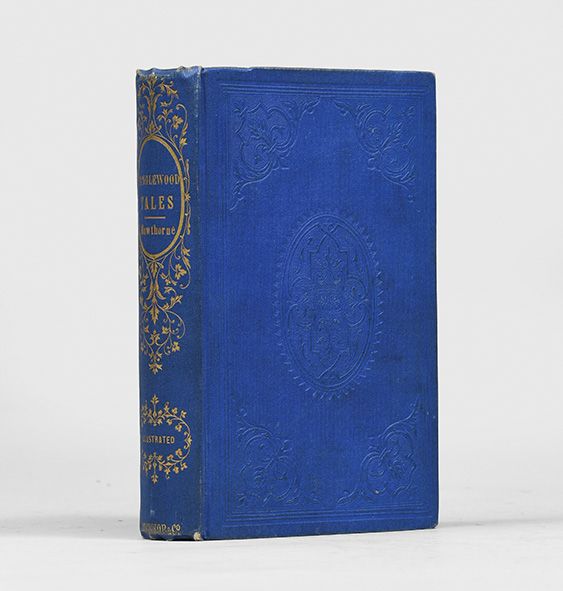Available Copies from Independent Booksellers

Price: US$3229.01 + shipping
Description: First US edition, first issue, of Hawthorne's sequel to The Wonder Book (Boston, 1852), retelling the Greek myths for children. This copy has a loosely inserted envelope addressed to the publisher, penned and initialled by Hawthorne. This edition, preceded only by the UK edition of the same year, has the following issue points: the "Stereotyped at the Boston Stereotype Foundry" mention to the copyright page; the omission of price in the list of Hawthorne's works (later issues having the price of 88 cents); and the publisher's ads dated "August, 1853", in the second state, listing the present title as "just out" (p. 2). Small octavo. Original blue cloth, spine lettered and decorated in gilt, decorationsin blind to boards, pale yellow coated endpapers. Housed in custom blue cloth chemise and matching quarter morocco slipcase, spine lettered in gilt (a hint of wear). Additional engraved title, 6 engraved plates, 8 pp. of publisher's advertisements at front. Gilt morocco bookplate of Katharine de Berkeley Parsons (1897-1993); embossed booksellers stamp of Gray Sprague & Co. to first leaf of ads. Minute wear to corners, faint soiling, the binding otherwise sound and bright, occasional spotting to contents, else internally fresh; a very good, attractive copy indeed.
Seller: Peter Harrington. ABA/ ILAB., London, United Kingdom

Price: US$48000.00 + shipping
Condition: Near Fine
Description: Illustrated by Hammatt Billings, with a frontispiece and six plates. First edition, first printing, without the Geo. C. Rand imprint on the copyright page, without the publisher's advertisements. Presentation copy, inscribed by Hawthorne to his close friend Henry Bright on front free endpaper: "Mr. H. A. Bright. / With the author's regards." Publisher's bright blue cloth, with boards decorated in blind, spine decorated and lettered in gilt, pale-yellow coated endpapers. Near fine, with light soiling to cloth, light rubbing to spine ends, bright gilt, corners slightly bumped, light soiling to endpapers, bookplates of Henry A. Bright and modern owner to front pastedown, and a small spot of soiling to p. 44 and a few surrounding pages. A tight and attractive unsophisticated copy. The only other inscribed copy of this title that we have seen was one we handled from a private collection that we then sold in 2016. Housed in a custom blue quarter-leather slipcase with folding chemise. BAL 7614. Tanglewood Tales is a collection of retold stories from ancient Greek mythology and the sequel to Hawthorne's A Wonder-Book for Girls and Boys (1851). Specifically, it includes "The Minotaur," "The Pygmies," "The Dragon's Teeth," "Circe's Palace," "The Pomegranate Seeds," and "The Golden Fleece." As with the stories in Wonder-Book, Hawthorne adapted these classic tales for younger readers not only by simplifying their plots, but also by removing "every thing that is abhorrent to our Christianized moral sense" and inserting the "blessed sunshine" of the Greek tragedians. Henry Arthur Bright (1830 - 1884) was an English merchant and author (Year in a Lancashire Garden, 1879). Bright met Hawthorne in Concord, MA in 1852, by a letter of introduction from mutual friend Henry Wadsworth Longfellow. The next year, Hawthorne settled in Liverpool as American Consul; they became close friends and traveled extensively throughout England together. Bright was a literary critic for the Examiner and a contributor to the Athenaeum. In 1855, Bright wrote a humorous piece about Hawthorne in the style of Longfellow's "Song of Hiawatha" titled "Song of Consul Hawthorne." In his essay "Consular Experiences" (1863), Hawthorne wrote of Bright: "Bright was the illumination of my dusky little apartment, as often as he made his appearance there!" When Hawthorne died in 1864, Longfellow wrote to Bright, "I am glad to know how deeply you feel this loss; for I know, having heard it from his own lips, that he liked you more than any man in England."
Seller: B & B Rare Books, Ltd., ABAA, New York, NY, U.S.A.